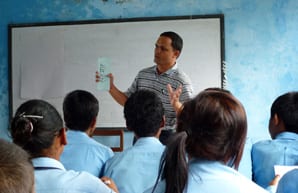If you build it, will they save? A groundbreaking study aims to find out, determining whether the opportunity and the product features will entice youth in developing countries to bank their money.
Representatives from the Center for Social Development at Washington University recently traveled halfway around the world to meet with colleagues from the YouthSave Consortium, and had the unique opportunity to talk with Nepalese youth and learn more about their savings experience.
TheYouthSave initiative is a five-year study supported by The MasterCard Foundation to investigate the potential of savings accounts as a tool for youth development and financial inclusion in four developing countries. Project partners convened in Kathmandu, Nepal, at the end of August for the 2012 Learning and Exchange Event. The result was a more complete understanding of all aspects of the project, as representatives from the YouthSave consortium, financial partners, research partners and the funder sat in the same room to share lessons, tackle challenges and explore strategies for moving forward.
The three-day conference was packed with productive and informative sessions, including country meetings, where a team consisting of financial partners, research partners, and program staff from each country discussed successes, challenges and early research findings. In another session, a panel of program experts related lessons they’ve learned from projects in other countries that will be helpful for YouthSave’s work in Colombia, Ghana, Kenya and Nepal.
“The conference really was the complete package, as we all shared information, addressed challenges and strengthened relationships,” said Li Zou, CSD’s YouthSave project director. “Face-to-face interactions were far more effective to accomplish those things compared to communicating over the phone or e-mail.”
The interactions continued on the last day of the conference, when attendees took a field trip to two Nepalese schools, where children were participating in a YouthSave financial education workshop and making deposits into their savings accounts. YouthSave conference attendees observed the activities and participated in a question-and-answer session with the students.
In talking with the youth, conference attendees learned that students do have money to save, but need a place to save it. Youth sometimes put money into their accounts that they’ve saved from trips to the market for their parents, when they’re allowed to keep any change from the purchase. Others may do odd jobs to acquire the money or receive monetary birthday and holiday gifts.
As preliminary research indicates, many students said they are saving for education-related costs, while others are saving for family needs or are planning to purchase new clothes and accessories for upcoming festivals. Students who don’t currently have YouthSave accounts told conference participants that watching their classmates save provides motivation for them to save, as well.
At the end of the session, students made deposits into their accounts using an in-school banking model, where a few students have been trained to take the deposits and record them in a ledger. Two of the students who made deposits spoke at a stakeholder meeting during the conference, and were highly expressive in articulating the value and impact of saving for their future.
YouthSave aims to do just that – brighten the future of these groups of low-income youth. “Our theory is that having money and control of that money brings with it other benefits, both tangible and intangible,” said CSD Director of Administration Lissa Johnson. “But the infrastructure has to be in place, to allow as much access as possible.” It can mean improved health and access to further education. In many cases, it just means hope.
YouthSave co-creates tailored, sustainable savings products with local financial institutions and assesses their performance and development outcomes with local researchers. The project is coordinated by Save the Children, in partnership with CSD, the New America Foundation and the Consultative Group to Assist the Poor (CGAP). The CSD team works closely with its research partners in each country to collect and analyze the data across all four countries, tracking saving patterns, interviewing youth about their savings, and, in one country, conducting an experiment to understand the impact that saving has on developmental outcomes like health and education.
Planning for YouthSave began in 2009, and the project is funded from 2010-15. Product piloting was completed in December 2011, and countries officially began offering the accounts in spring 2012.
Between rollout in the spring and June 30, 2012, a total of 3,094 youth opened accounts across the four countries. Of those, 765 have consented to participate in the research study. Youth in the study have saved a total of $36,429.50 thus far. The majority of participating youth heard about the program through the media, school or bank outreach. Most are currently enrolled in school, and say they are saving for costs associated with education.
The project will report quarterly on account uptake and savings. These reports will be available at CSD’s website – http://csd.wustl.edu.
The research team representatives at the Nepal event were Li Zou, Lissa Johnson, and YungSoo Lee, all from CSD; Vilma Ilic from Columbia University; Manik Ram Maharjan, Jyoti Manandhar, and Sherad Sharma, all from New ERA in Nepal; Ernest Appiah from the University of Ghana; Moses Njenga from KIPPRA in Kenya; and Juan Saavedra from University of the Andes in Colombia.
